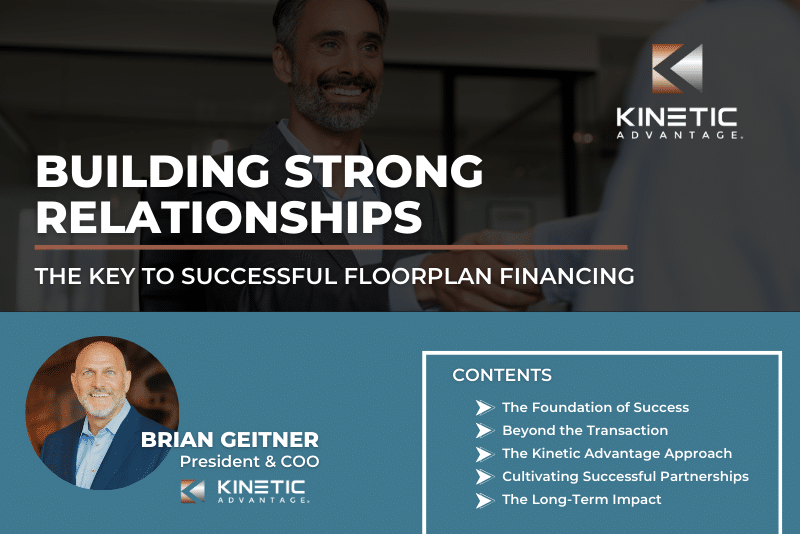As a business owner, the most important questions you face each day are how to best utilize capital to operate and grow your independent dealership, and more importantly, whether you have sufficient working capital to achieve your growth objectives. The key difference between dealerships that experience little to no growth versus those whose growth surpasses that of their market is the way successful dealers put capital to work for them, as well as the different types of capital they utilize.
A dealership’s ability to tap into additional sources of capital can provide them with the ability and flexibility to grow their business without restraints and restrictions of limited capital access. Smart dealerships will often use their capital for smaller dollar items such as monthly expenses, benefits, etc., and then choose to utilize other sources of capital for larger dollar items.
What are some different types of capital that independent dealerships can tap into to propel growth? There are several options available to dealerships that provide varying levels of flexibility, including small business loans, revolving lines of credit, home equity loans, equipment leasing, floor plans, and private investors.
These options, and a dealership’s ability to qualify for them, can vary depending on several factors, such as time in business, personal credit, business plan, home equity and commercial real estate equity, personal net worth, current balance sheet and P&L along with working capital.
Revolving lines of credit, home and commercial equity loans, and equipment leasing are typically a more involved process that may include review of business plans, business financial performance, personal credit of dealership principals, working capital, property appraisals and current business creditors. Typically, equipment leases, small business loans and floorplan lines of credit will be the easiest capital for dealerships to be approved for.
Why is putting capital to work for your dealership so important? Simply stated, it can provide you additional flexibility to increase your dealership’s revenue and bottom line. How can it achieve this? Additional capital can allow you to: improve the in-person and digital appearance of your dealership, provide you with the ability to acquire more inventory, hire additional team members, add locations, increase advertising and marketing, invest in new technology to create efficiencies while improving your customer acquisition process, and be more aggressive in your pursuit of new business.
To capture prospective customers attention, dealers need to separate themselves from the competition. What are some things that dealers can do to attract more customers? Since you cannot sell what you don’t have, and customers are more likely to visit a full lot than one that is sparse, having a larger inventory is a great place to start. Updating the appearance of your dealership is another great idea. Perhaps a fresh coat of paint on the building or a newly paved lot? Maybe an updated showroom or office area to make it more appealing? What about adding additional locations to tap into other areas of your market?
Today’s customers are very savvy and perform more research online than ever before. A great way to attract new customers to your dealership is through creative advertising and marketing; however, it can be very costly. Dealers will often push advertising and marketing to the side because of costs. A successful marketing campaign requires a solid budget and, sometimes, outside assistance. Small dealerships often neglect this aspect of their business to use their budget in other areas of their business. However, marketing is an essential part of growth, and a successful marketing campaign can increase sales in a short amount of time. Whether your dealership needs a website, social media promotion or mailer campaigns, having access to more capital creates an opportunity for you to grow through marketing.
An important, and often challenging, way to increase productivity and function of a dealership is to update or acquire new equipment or technology. Updated equipment and technology can help streamline a dealership’s operations and create efficiencies. It can be difficult for some dealerships to acquire these assets, as new equipment and technology can be very expensive. While a dealership may be profitable, it may not have the working capital at hand to spend on expensive equipment that can depreciate over time. This is an area where utilizing additional capital can be very beneficial.
Are there products or services that your dealership could sell to increase your bottom line? New products/services are a great way to increase interest and traffic for a dealership, especially if others in the area do not provide it. Perhaps you could create tire and wheel packages or add a service department. Would increasing products/service require an increase in staff, new equipment, or an expansion of the dealership location? Dealerships often realize there is a demand for an additional product/service that they could provide, but they aren’t willing to cut into current budgets to add it. Utilizing other sources of capital could be a great way to pursue these new opportunities.
Have you thought about adding another location for your dealership or pursuing different niches within your market? Adding another location or venturing into a new niche market can be very costly for a dealer. The upfront costs alone often prevent dealers from expanding. With that said, the profitability of a dealership can increase substantially from such a move. Investing in expansion using your own capital will tie up your ability to use those funds to continue your existing growth. On the contrary, utilizing short-term financing can prevent a dealer from cutting into current costs and further increase their customer base.
Having the right inventory on hand is crucial for a dealership’s success; however, acquiring inventory is the single largest expense for a dealership. A dealer’s ability to maximize their inventory may only be limited by the capital they have on hand to procure it. Dealers need the ability to acquire units from multiple sources, including auctions, private-parties, trade-ins, consumer loan payoffs, and dealer-to-dealer purchases. Many dealers are not able to take advantage of all these available options due to limited or restricted capital. Additional capital would allow a dealer to maximize their inventory acquisition strategy and, in turn, produce more sales.
For profitable dealerships, adding debt can seem counter intuitive, but there are several ways in which expanding your capital resources can provide your dealership with opportunity to expand beyond your current growth plans. Utilizing additional capital resources can be the catalyst your dealership needs to increase overall profitability and propel larger long-term growth. Knowing the right capital to utilize and how to best deploy that capital is the key to putting capital to work for your dealership.
What Drives You?
What Drives You?
The dealership floorplanning newsletter that takes a look into recent floorplan news & trends, as well as updates from inside the walls at Kinetic Advantage.
(We promise not to spam you or inundate your inbox with emails. Our newsletter goes out roughly twice per month to include important news and information around dealer floorplanning.)






